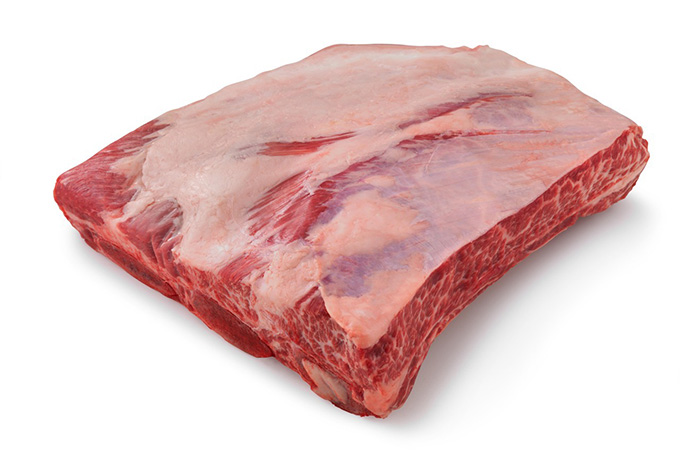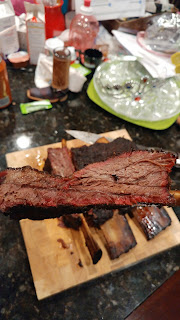For today's cook, we're going to be doing beef short ribs. The name, however, doesn't necessarily refer to the size, but refers to where the ribs are cut: the short plate of the cow's rib section. Usually, you will find short ribs in your local supermarket cut into individual rib sections a few inches in length, like this:
Don't let the size fool you...
Looks like a book of meat..
Because of their size, they can be cooked a number of ways: smoked, braised, crock pot, fried, sous vide, etc. For presentation sake, we're looking for something like this:
Sometimes these are called plate ribs, or 'dino ribs', because of the size of the bone. Now, I could go on about different cuts of beef ribs and where they come from on the cow, but that will take too long and we've got to get cooking. If you want to know, watch the video below:
With that out of the way, let's get to the business of cooking these ribs. As always, preparation is key, but not very difficult (and really not much different than your pork ribs). First, buy the ribs.
These ribs are usually cryovac'd in 2 to 4 rib sections. I found these at my local big box store (BJ's) but places like Restaurant Depot carry them as well. If you don't see them in the refrigerator case, ask the butcher and see if they have any on hand. Next it's time to clean the ribs up. Set the racks on your cutting board for prep.
As with pork ribs, there is a membrane on the back of each slab which can be removed. Is this 100% necessary? Depends on who you ask. There's no meat back here, so worrying about a crunchy bit of membrane isn't too much of a concern, as you're not going to eat it. Also, if you're not careful, pulling the membrane could cause the meat to separate from the bone. On the other hand, some reason that the membrane would inhibit the smoke from penetrating the ribs. Your call. For this cook, I'm removing the membrane, as it's not hard to do. Grab your butterknife and slide it between the membrane and one of the rib bones. Once you lift it up, use a paper towel to remove the wax papery film.
Next, flip the ribs over and assess what needs to be done. Again, we've got a decision to make
We've got a ton of fat and silverskin on the top of this rack, and underneath is all the beefy goodness that will make this cook worth it. The decision is whether or not to remove that fat. Now, a lot of people will leave the fat on the ribs as is, reasoning that the fat will render off and baste and flavor the meat during the cook. The fat could also act as a heat barrier to keep the meat from burning over the long cook. Others reason that only so much of the fat will render off, and the rest will simply remain on top of the meat once we're done cooking. The rub would then only be on the fat, as it can't really penetrate through the fat to the meat. Or, as the fat is rendering off the rub would drip away with the fat. While I'm firmly in the latter camp, there are legions of people, including renowned pitmaster Aaron Franklin, who take the side of the former. I won't say which was is right or wrong. You decide on your preference and/or how much time you have . For this cook, that fat is coming off. Much like a brisket, you can spend over an hour removing every little piece of fat and silverskin you see, or you can just cut off the biggest pockets and leave the rest to render during the cook. Totally up to you. A sharp knife makes the job a lot easier.
Once you're done slather the ribs with a binder of your choice (hot sauce, like Mr. Franklin uses, mustard, oil, etc) and coat the ribs with the rub of your choice. Generally any rub that goes good with steak works perfectly on these ribs, as the strong flavor of beef doesn't really need the sweetness that a pork rub would generally have. A simple salt/pepper.garlic/chili powder rub would work wonders on beef ribs. That said, let your personal palate be the judge, not mine. The ribs will taste great regardless.
That's pretty much it for prep work. You can either put the rub on as you're getting the cooker ready to roll or park the ribs in the fridge overnight to 'dry brine' the ribs until you're ready to cook them. Set the cooker up for indirect cooking at a temp of 250-275 degrees. Place the ribs on the cooking grate bone side down and let them roll. The ribs will be on for about 5-7 hours as this temp, depending on the thickness of the meat on the bones. If the cooker runs hot, or if the ribs look like they are drying out, feel free to spritz them with water or beef broth. The cook will be done when the internal temperature hits 203 degrees (I'm not even going to ask if you have your thermometer for the food or cooker, because if you don't by now I don't even know what to say). The probe (or toothpick) should slide through the meat like melted butter. Pull them off the cooker, wrap them in foil for about 30 minutes and let them rest. After that, it's time to feast:
Look at the bark. Notice the smoke ring. give the meat a squeeze and see the juices start to ooze. Not have a bite. It's tender, like filet mignon, but much more flavorful, like a rib eye. It's like brisket on a stick.
Good eats to all until next time
Good eats to all until next time











